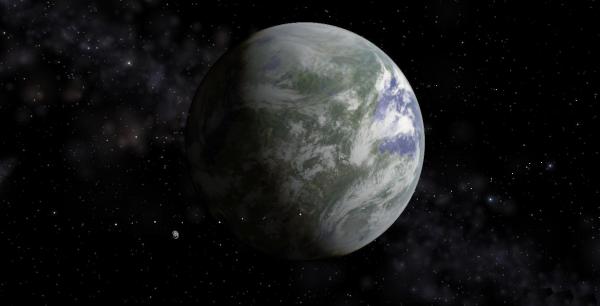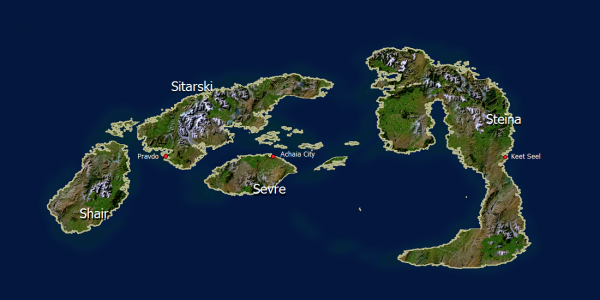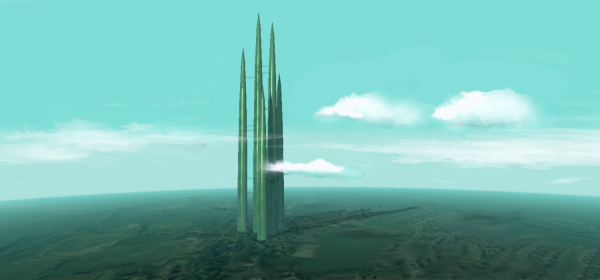BY LETTER
Orwell (Garden World)
Galactography > Regions of Space > Middle Regions/Hinter-regions
Galactography > Systems and Worlds > Systems & Worlds O - P
Galactography > Systems and Worlds > Systems & Worlds O - P
 Image from Steve Bowers |
Orwell - Data Panel | |
| System | Star's Name: Norton, JD 5560221 Stellar Type: K3 (Norton is a relatively old example) Distance from Sol: 1954 ly Location: Near NGC 6885, in Vulpecula Mass: 0.8 Solar Luminosity 0.3 Solar Planets 1) Machin - massive and hot Euarean world 2) Orwell - terrestrial natural garden world 3) Meyermann - minor iceball; center of much of the volatiles industry 4) Susi - major gas giant; heavily industrialised 5) Wirt - gas giant 6) Zdenka - small gas giant 7) Zu Chong-Zhi - gas giant |
|---|---|
| Orwell | Distance from Primary: 0.53 a.u. Insolation: 1.06 times Earth's Diameter: 12,833 km Density: 1.1 Earths Mass: 1.19 Earth Gravity: 1.13 G Air pressure: 1.12 atm Axial Tilt: 1° Length of Day: 16h 54m 22s Length of Year: 0.43 Earth's (223.67 local days) Tidal Effects of Norton: 5.4 times Sol's effect on Earth (tides 1.7 to 4.7 times Earth's) Average Temperature: 30° C |
| Population | Population by World (millions) Orwell: 1091 Circumference: 2230 Julia Aurore: 30 Yazhi: 60 Tirela: 20 Strand: 20 Aegle: 0.01 Population by Clade (percentages) Cyborg: 22% Su: 19% AI: 19% Human Baseline: 18% Vec: 11% Rianth: 5% Virtual: 3% Provolve: 2% (mainly enhanced dolphins and manatees) Xenosophont: 1% |
 Image from Steve Bowers | |
| Orwell | |
The Orwell system is the capital system of the Chronos Cluster. It was colonised in 5502 AT by a colonisation fleet from Criw-Ta, a Cygexpa client world. Criw-Ta was at the time going through its most baroque bureaucratic phase, and the colonists largely left in order to escape the stifling gerontocracy that held the power and limited all initiative. They named the main world Orwell as a reference to an ancient anti-bureaucrat personality, and the rest after famous people in Criw-Ta and earlier history.
In order to protect the native biosphere, colonists have all been modified to be biocompatible with the local environment. Tweaked nearbaseline humans with a modified biology form a sizable minority alongside a (similarly tweaked) large su and cyborg contingent. Any biont or biont/aioid hybrid sophont must utilise a biocompatible internal flora to avoid contaminating the local biosphere; this internal flora may be genetically-engineered local organisms, or entirely artificial. Many AIs and vecs have also settled in the system.
As the rest of the Cluster was colonised many discontents emigrated, but after a few generations their prosperous descendants often returned to visit the old ancestral home. Together with the occasional immigrants from the Cygexpa volumes this contributes to the system being a melting pot of beings and ideas. Over its history a metropolitan culture has developed, accepting mixed-clade relations and fairly radical clade-shifting.
Orwell's government is a close derivative of the First Federation: a parliament of representatives with AI decision support and a federal division of power. It keeps the system peaceful but doesn't interfere unduly with business (especially after the QDG coup), instead working more on the long-range development of the system and cluster.
The status of Orwell as the leading or at least central system of the Chronos Cluster has varied extensively over its history, but due to its location and the Tianzi wormhole it is always an important system. Extensive catapult launches are done from the Aegle volumes and the industries of Susi supply much of the cluster with useful tools and devices such as Orwellian consoliders, naughtyboxes or pan-malplons.
The orange light of Norton produces the distinctive Orwellian turquoise sky. Orwell has two small moons, Winston and Julia (34 and 84 kilometres in diameter respectively), orbiting 240,000 and 430,000 kilometres away. Due to their small size Orwell has periodically shifted between high and low inclination axial tilt (controlled by a resonance with Machin) the last billion years; in the past this led to regular and long ice ages, but they ended 200 million years ago.
Orwell is a fairly old world, although it is still geologically active. However, the slow increase in luminosity of Norton means that the planet will enter a runaway greenhouse effect within 30-40 million years. In order to manage this problem, resources for long- and short range biosphere maintenance are being collected in the mighty Biosphere Maintenance Fund, one of the major political influences in the system.
70% of the surface is water, with four main continents called Steina, Sitarski, Shair and Sevre. Between them are extensive archipelagos and shallow seas teeming with native life. Especially notable are the bamboo seas near the equator, where a local bamboo-like species of floating plants with weighted roots and buoyant stems forms dense undulating forests on the water.
The weather is more hot and humid than on Earth, with spectacular tropical thunderstorms in the afternoons in the tropics. In order to protect the local microbiota, any unmodified Terragen visitors to this planet must constantly wear hermetically sealed envirosuits when outdoors; envirosuits in the current era are discrete and comfortable, and are almost completely undetectable by the wearer or an outside observer.
Orwellian life is very similar to Earth life, although it uses a somewhat different DNA genetic code. Plants tend towards having large blue-green leaves and long hollow stems housing symbiotic animals. Since carbon dioxide is fairly limited they also complement air by breaking down carbonate rocks, creating the amazing biokarst landscapes of Steina and Shair. Animals exist in all sizes and shapes, often involved in complex symbioses with different species of plants. Several taxa of animals are deeply linked with plant taxa. Their co-evolution has lasted for hundreds of million of years. Animals protect and support their "parent plants", sometimes attacking other plant species.
 Image from Steve Bowers | |
| A skyneedle city on Orwell. Building regulations on this planet require that habitable structures have a very limited footprint at ground level, to minimise disturbance to the local environment. All waste materials must be recycled within the building, and any tourist leaving the structure must wear a biologically sealed envirosuit. | |
In order to minimize ecological impact, building on Orwell is highly regulated and only allowed in designated areas or exploiting low-impact methods. Most cities tend to build vertical; kilometre-high but very thin skyneedles pierce the clouds, and continue as groundscrapers beneath the ground. Some cities are mainly subterranean, while the three largest cities Achaia City(Sevre), Keet Seel (Steina) and Pravdo (Sitarski) are built around the foundations and length of the three beanstalks that extend to orbit. Having an above-ground apartment with great view is regarded as a sign of status.
Surrounding Orwell is Circumference, the main orbital band. This is where most of the Orwell population lives, with easy access to the planet and other habitats. Most of the government functions are here, in the Arc of Jahe complex. Another important "location" is Hirai Modulus, the main upscale AI neighbourhood in the nets.
Other major population centres in the system:
Julia Aurore - Station complex in, on and around Julia. Headquarters of the QDG. 30 million inhabitants of all clades.
Yazhi - Orbital around Susi, a major industrial centre.
Tirela - Moon of Susi, inhabited mainly by vecs in the energy business and the Tirela clade of radiation resistant su.
Strand - Wormhole and terminus facilities located 500 AU from the star.
Aegle - catapult volume above the ecliptic plane, administered from Aegle 1-5, space stations in high inclination orbits.
Related Articles
Appears in Topics
Development Notes
Text by Anders Sandberg
Additional material by Steve Bowers
Initially published on 22 November 2000.
Planet, planet map, and sky needle images added 2011 by Steve Bowers
minor formatting edits added November 2014
Additional material by Steve Bowers
Initially published on 22 November 2000.
Planet, planet map, and sky needle images added 2011 by Steve Bowers
minor formatting edits added November 2014






